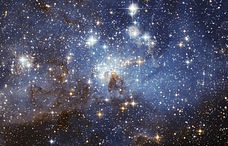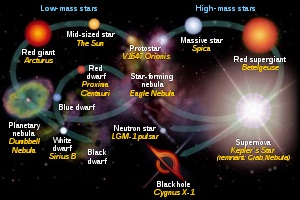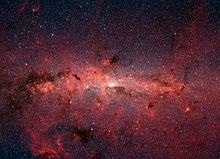|
|
| |
|
|
| |
|
|
|
|
| |
 |
| A star-forming
region in the Large Magellanic Cloud. |
Stars
A star is a massive ball of plasma (very hot gas) held
together by gravity. It radiates energy because of the
nuclear reactions inside it
It radiates heat and light, and every other part of the
electromagnetic spectrum, such as radio waves,
micro-waves, X-rays, gamma-rays and ultra-violet
radiation. The proportions vary according to the mass
and age of the star.
The energy of stars comes from nuclear fusion. This is a
process that turns a light chemical element into another
heavier element. Stars are mostly made of hydrogen and
helium. They turn the hydrogen into helium by fusion.
When a star is near the end of its life, it begins to
change the helium into other heavier chemical elements,
like carbon and oxygen. Fusion produces a lot of energy.
The energy makes the star very hot. The energy produced
by stars radiates away from them. The energy leaves as
electromagnetic radiation. |
|
 |
| Stellar evolution of
low-mass (left cycle) and high-mass (right
cycle) stars, with examples in italics. |
Birth of a star
A star begins as a collapsing cloud of material made
mostly of hydrogen, with helium and tiny amounts of
heavier elements. Once the stellar core is dense enough,
some of the hydrogen is changed into helium through
nuclear fusion. The energy moves away from the core by a
combination of radiation and convection. The star's
radiation stops it from collapsing further under its own
gravity. Once the hydrogen fuel at the core has been
used up, those stars with at least 0.4 times the mass of
the Sun expand to become a red giant. In some cases they
fuse heavier elements. When the star is very old it
might expand until its outer layers are pushed away. If
the star is heavier, it might explode and spread most of
its mass into space. The matter it spreads into space
may make a new generation of stars. If the star is even
larger it may collapse and form a black hole.
Earth and Sun
The star nearest to Earth is the Sun. It is not accurate
to say "most of the energy on Earth comes from it". It
is more accurate to say the energy of sunlight supports
almost all life on Earth by photosynthesis, and drives
Earth's climate and weather. The Earth has its own
source of heat in its interior: see Age of the Earth.
The internal heat comes from the original gravitational
formation of the Earth, and from the radioactive
materials inside it.
We can see other stars in the night sky when the Sun
goes down. They are made mostly of hydrogen and a little
bit of helium plus other elements. The sun is such a
star.
Planets
Most stars look like shiny dots from Earth, because they
are far away. Our Sun is the closest star to us. The
earth and other planets move around (orbit) the Sun. The
Sun and all things that orbit it are called the Solar
System. Many other stars have planets orbiting them:
they are called exoplanets. |
|
 |
| The infrared image
from NASA's Spitzer Space Telescope shows
hundreds of thousands of stars in the Milky Way
galaxy. |
Numbers, distances
The nearest star to our Solar System, and the second
nearest star to Earth after the Sun, is Proxima
Centauri. It is 39.9 trillion kilometres away. This is
4.2 light years away, meaning that light from Proxima
Centauri takes 4.2 years to reach Earth.
Astronomers think there are a very large number of stars
in the Universe. They estimate (guess) that there are at
least 70 sextillion stars. That is
70,000,000,000,000,000,000,000; which is about 230
billion times the number of stars in the Milky Way (our
galaxy).
Most stars are very old. They are usually thought to be
between 1 and 10 billion years old. The oldest stars are
thought to be around 13.7 billion years old. Scientists
think that is close to the age of the Universe.
Stars vary greatly in size. The smallest neutron stars
(which are actually dead stars) are no bigger than a
city. The neutron star is incredibly dense. If you were
to take a layer a micrometre thick and apply it onto a
tank, it would be a very tough armor. The tank would be
so heavy, it would sink into the center of the Earth.
Hypergiant stars are the largest stars in the Universe.
They have a diameter over 1,500 times bigger than the
Sun. If you changed the sun into one of these huge stars
down where the sun is, its outer surface would reach
beyond the orbit of Jupiter, and the earth would be well
inside the star. The star Betelgeuse, in the Orion
constellation is a red supergiant star.
When seen in the night sky without a telescope, some
stars appear brighter than other stars. This difference
is measured in terms of apparent magnitude. There are
two reasons for stars to differ in apparent magnitude.
If one star is much closer than another otherwise
similar star, it will appear much brighter, in just the
same way that a candle that is near looks brighter than
a big fire that is far away. If one star is much larger
or much hotter than another star at about the same
distance, it will appear much brighter, in just the same
way that if two fires are the same distance away, the
bigger or hotter one will look brighter. A star's true
luminosity is its absolute magnitude.
Beside light, stars also give off a solar wind and
neutrinos. These are very small particles.
Stars are a source of a gravity field. This is what
keeps planets close to them. It is also not unusual for
two stars to orbit each other. This happens when they
are close together. This is also because of gravity, in
the same way as the Earth orbits the Sun. These binary
stars (binary meaning "two") are thought to be very
common. There are even groups of three or more stars
orbiting each other. Proxima Centauri is the smallest
star in a group of three.
Stars are not spread evenly across all of space. They
are grouped into galaxies. A typical galaxy contains
hundreds of billions of stars.
History of seeing stars
Stars have been important to people all over the world
for all of history. Stars have been part of religious
practices. Long ago, people believed that stars could
never die. Astronomers organized stars into groups
called constellations. They used the constellations to
help them see the motion of the planets and to guess the
position of the Sun. The motion of the Sun and the stars
was used to make calendars. The calendars were used by
farmers to decide when to plant crops and when to
harvest them. |
|
 |
| The Pleiades, an
open cluster of stars in the constellation of
Taurus. These stars share a common motion
through space. |
The life of stars
Stars are made in nebulas. These are areas that have
more gas than normal space. The gas in a nebula is
collected by gravity. The Orion nebula is an example of
a place where gas is coming together to form stars.
Stars spend most of their lives burning (fusing)
hydrogen to make energy. When hydrogen is fused it makes
helium. To fuse hydrogen it must be very hot and the
pressure must be very high. Fusion happens at the center
of stars, called "the core".
The smallest stars (red dwarfs) fuse their hydrogen
slowly and live for 100 billion years. Red dwarfs live
longer than any other type of star. At the end of their
lives, they become dimmer and dimmer. Red dwarfs do not
explode.
When very heavy stars die, they explode. This is called
a supernova. When a supernova happens in a nebula, the
explosion pushes the gas in the nebula together. This
makes the gas in the nebula very thick. Gravity and
exploding stars both help to make new stars in nebulas.
Most stars use up the hydrogen at their core. When they
do, their core shrinks and becomes very hot. It becomes
so hot it pushes away the outer layer of the star. As
the outer layer expands it makes a red giant star. Astro-physicists
think that in about 5 billion years, the sun will be a
red giant. Our sun will be so large it will eat the
Earth. After our sun stops using hydrogen to make
energy, it will use helium in its very hot core. It will
be hotter than when it was fusing hydrogen. Heavy stars
will also make elements heavier than helium. As a star
makes heavier and heavier elements, it makes less and
less energy. Elements as heavy as iron are made in heavy
stars.
Average stars (like our sun) will push away their outer
gases. The gas it pushes away makes a cloud called a
planetary nebula. The core part of the star will remain.
It will be a ball as big as the Earth and called a white
dwarf. It will fade into a black dwarf over a very long
time.
Later in large stars, heavier elements are made by
fusion. Finally the star makes a supernova explosion.
Most things happen in the universe so slowly we do not
notice. But supernova explosions happen in only 100
seconds. When a supernovae explodes its flash is as
bright as a 100 billion stars. The dying star is so
bright it can be seen during the day. Supernova means
"new star" because people used to think it was the
beginning of a new star. Today we know that a supernova
is the death of an old star. The gas of the star is
pushed away by the explosion. It forms a giant cloud of
gas called a planetary nebula. The crab nebula is a good
example. All that remains is a neutron star. If the star
was very heavy, the star will make a black hole. Gravity
in a black hole is extremely strong. It is so strong
that even light cannot escape from a black hole.
The heaviest elements are made in the explosion of a
supernova. After billions of years of floating in space,
the gas and dust come together to make new stars and new
planets. Much of the gas and dust in space comes from
supernovae. Our Sun, the Earth, and all living things
are made from star dust.
Colors
Astronomers have known for centuries that stars have
different colors. When looking at an electromagnetic
spectrum, ultraviolet waves are the shortest, and
infrared are the longest. The visible spectrum has
wavelengths between these two extremes.
Modern instruments can measure very precisely the color
of a star. This allows astronomers to determine that
star's temperature, because a hotter star's black-body
radiation has shorter wavelengths. The hottest stars are
blue and violet, then white, then yellow, and the
coolest are red. Knowing the color and absolute
magnitude, astronomers can place the star on the
Hertzsprung-Russell diagram, and estimate its habitable
zone and other facts about it.
For example, our Sun is white, and the Earth is the
perfect distance away for life. If our Sun was a hotter,
blue star, however, Earth would have to be much farther
away or else it would be too hot to have water and
sustain life. |
|
 Kiddle:
Stars Kiddle:
Stars
Wikipedia: Stars |
|
|
|
|
|
|
|
|
|
|
|
|
|
|
|
|
Search Fun Easy English |
|
|
|
|
|
|
|
|
|
|
|
|
|
|
|
About
Contact
Copyright
Resources
Site Map |